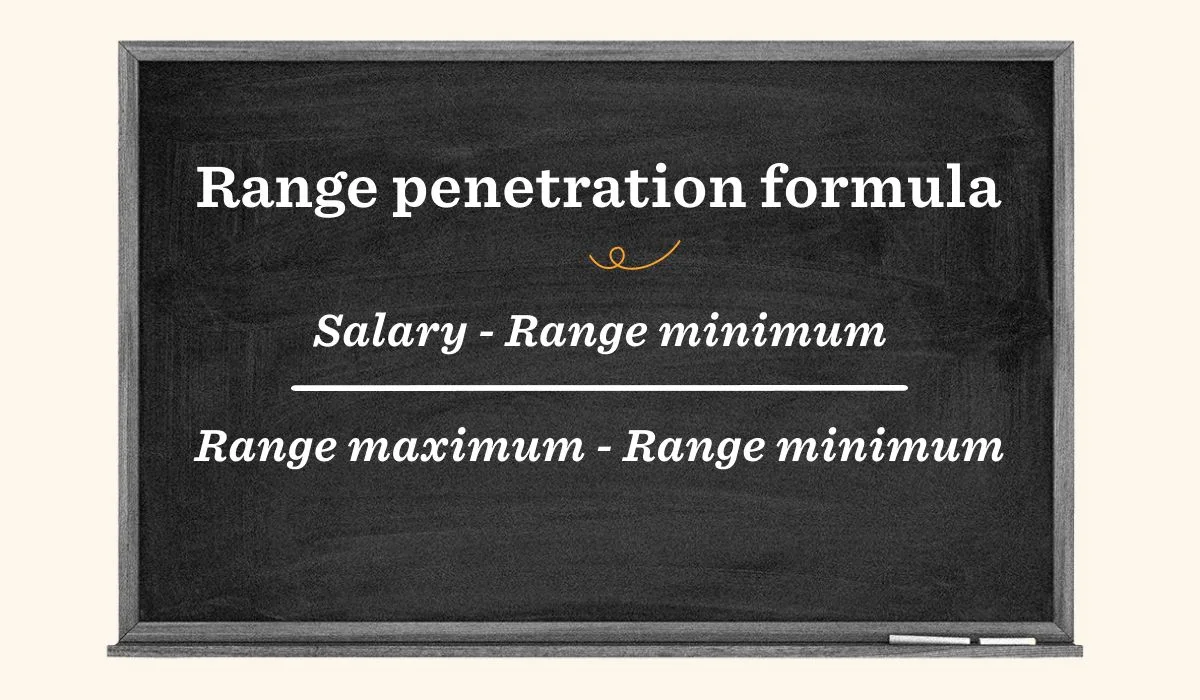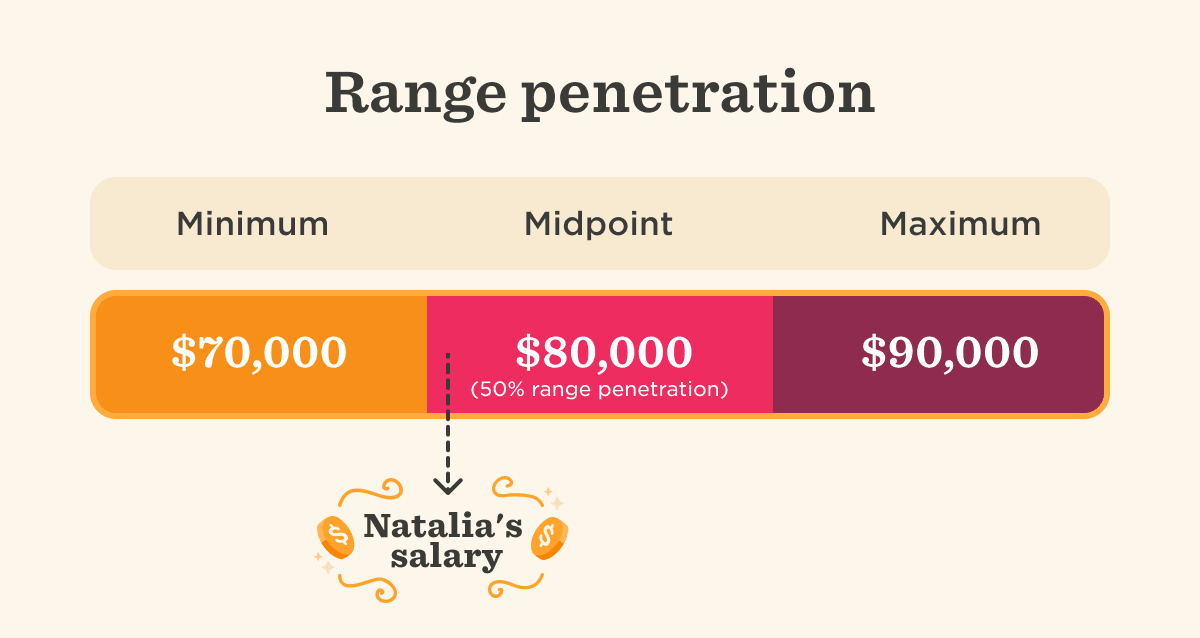Salary range penetration shows how far an individual’s salary has progressed within their role’s pay range, typically expressed as a percentage. When paired with structured salary bands, it brings clarity and consistency to pay decisions—building trust and supporting retention through fair, contribution-aligned compensation.
Low pay continues to be a top reason people leave their roles. According to SHRM’s report, 20 percent of professionals who quit cited unsatisfactory pay. Raises also play a part—ADP research shows that people expect average increases of more than five percent.
If you suspect low salaries are the main reason for turnover at your company, then it’s time to explore whether you are paying your people fairly and according to the market rate. While there are several metrics you can use to ensure fair pay, the salary range penetration formula is crucial for understanding and managing pay differences at your organization and how they impact employee satisfaction.
In this article, we’ll break down what salary range penetration means, why it matters for equity and retention, and how to measure it with impact.
<< Use our salary range penetration formula to make informed decisions.>>
What does salary range penetration mean?
Salary range penetration shows where a person’s salary falls within their assigned pay range. It’s calculated as a percentage—measuring how far their pay has progressed from the minimum to the maximum of the band.
This metric helps you compare pay across individuals, teams, and departments, making it easier to apply your compensation strategy consistently and spot any gaps.

What are salary bands?
Salary bands are structured pay ranges that define the minimum and maximum salary for each role or level within your organization. They provide a framework for setting starting salaries, planning raises, and managing pay progression over time.
Once your salary bands are in place, you can calculate salary range penetration to see where each person sits within their band—helping you make informed, equitable pay decisions.
Pay transparency and equity are at the heart of this approach. As Josh Bersin, a leading HR industry analyst, puts it: “Organizations that embrace pay equity not only align with societal expectations but also set themselves up for long-term success by fostering a culture of trust and fairness.”
Salary range penetration vs. compa-ratio
Both salary range penetration and compa-ratio help assess pay equity—but they highlight different aspects of compensation.
Compa-ratio compares a person’s salary to the midpoint of their salary band. For example, if a team member earns $60,000 and the midpoint of their band is $65,000, their compa-ratio is about 92 percent. This metric is useful for checking if pay aligns with internal or market benchmarks.
Salary range penetration goes further. It shows where someone’s pay sits across the entire range—from the minimum to the maximum. So while compa-ratio focuses on a single reference point, salary range penetration gives a fuller view—making it easier to spot pay gaps and manage progression. Used together, these metrics offer a more complete picture of your compensation strategy.
How to calculate and use the salary range penetration metric
Salary range penetration is a key metric to review once or twice a year—ideally alongside your salary bands during the annual compensation cycle. Here’s how to calculate it in a few simple steps:
- Identify the minimum and maximum salary for the role’s established pay band. Use your organization’s defined salary bands to determine the range boundaries for the position.
- Note the person’s current salary. This is the actual annual base salary the person currently earns.
- Apply the salary range penetration formula. (Salary – range minimum) ÷ (range maximum – range minimum) = range penetration. This shows how far the salary has progressed through the band.
- Convert the result to a percentage. Multiply the decimal by 100 to express the penetration as a percentage. For example, a result of 0.60 becomes 60 percent, meaning the salary is 60 percent of the way through the band.
- Compare the penetration percentage to your compensation philosophy and the person’s experience level. Evaluate whether the current placement aligns with your compensation strategy. For example, are early-career professionals typically placed in the lower third? Are high performers or senior team members expected to fall above the midpoint? This helps internal consistency and fairness while accounting for tenure, performance, and growth potential.
- Analyze results across demographic groups to flag potential pay equity concerns. Review penetration rates by gender, ethnicity, age, or other relevant demographics to uncover any unintended disparities. Significant patterns may signal the need to adjust policies or dig deeper into the underlying causes.
Salary range penetration tracking template
This free Excel template includes a built-in formula to calculate salary range penetration (SRP) once you’ve entered each team member’s salary and their salary band. Just input the minimum, maximum, and current salary—and the template will automatically show the SRP percentage.
Here’s a sample of how your data might look:

This format helps HR and compensation teams identify salary compression, promote consistency, and prioritize actions during comp planning cycles.
Once you’ve calculated SRP across your team, use these questions to guide your analysis:
- Where does each team member sit within their salary range? Are they below, near, or above the midpoint?
- How does their current salary compare to peers in the same role or level?
- Is their pay aligned with their experience, performance, and tenure?
- Are there inconsistencies—such as less experienced or lower-performing team members earning more?
- Does their track record suggest they’re ready for a raise or a band adjustment?
- Are any salaries at the very low or high end of the range? If so, do they require action?
- Have salary ranges kept pace with market trends or evolving role expectations?
- Is pay positioning fair and consistent across different locations, genders, or levels?
<< Get the salary range penetration template to spot salary compression early. >>
Recommended For Further Reading
Salary range penetration calculation example
Let’s take a look at an example.
Natalia is a marketing manager who earns $76,000 per year. The salary range for her role is between $70,000 and $90,000.
To discover Natalia’s salary range penetration, calculate as follows:
(76,000-70,000) / (90,000-70,000) = 0.3 or 30%.
With a salary range penetration of 0.3, Natalia is 30 percent into her salary range, with 70 percent left until she reaches the maximum salary in the range.

Why range penetration matters for retention
When people feel their pay isn’t fair—whether compared to peers or the market—it can lead to frustration and disengagement. Over time, this impacts how they see their role, their team, and the company. In many cases, it leads to turnover.
Tracking salary range penetration alongside market trends helps you stay ahead. Regular compensation reviews and thoughtful adjustments—through raises, promotions, or market-based changes—show your people they’re valued and have room to grow.
How salary range penetration is related to diversity and inclusion
Creating an inclusive workplace starts with fair pay. But despite progress, gaps still exist. According to Payscale’s 2024 Gender Pay Gap Report, women earn $0.99 for every dollar earned by men in the same roles—even when experience, education, and responsibilities are equal.
Tracking salary range penetration can help uncover hidden disparities across gender, race, age, and other demographics. If certain groups consistently fall lower in their salary bands, it could signal a compensation equity issue.
With these insights, you can take action—adjusting your pay strategy to close gaps and build a more equitable, transparent culture where everyone feels valued.
It’s time to close the pay gap
Closing pay gaps and ensuring equitable compensation is more than a best practice—it’s a business imperative. Salary range penetration calculation drives fairness, inclusion, retention, and engagement across your workforce.
Regularly reviewing pay practices helps uncover disparities, stay competitive, and build trust among your people.
<<Download the salary range penetration template for compensation analysis.>>
FAQs on salary range penetration
What is a good salary range penetration percentage?
Many organizations aim for an average salary range penetration of 50-70 percent, as this indicates that people are paid competitively while still allowing room for growth and merit-based increases.
What tools are available to calculate salary range penetration?
To calculate salary range penetration, you can use an HCM like Bob, which has built-in compensation analysis features. You can also use the salary range penetration formula within Excel or Google Sheets to calculate penetration percentages. Finally, you can use a salary range penetration calculator, such as this one from The Human Capital Hub.
What does position in range calculation mean?
Position in range calculation determines where a person’s salary falls within their assigned salary range, expressed as a percentage. This metric helps organizations assess if team members are underpaid, paid competitively, or overpaid relative to the range and their role.
What is the role of salary range penetration in promotions?
Salary range penetration plays a key role in promotions by guiding how much a team member’s pay increases when moving to a higher-level role. It helps ensure promotions align with internal pay structures and external benchmarks, preventing over- or underpayment. Organizations often adjust salaries to bring people closer to the new range’s midpoint based on experience, performance, and market competitiveness.
How often should salary range penetration be reviewed?
You should review salary range penetration annually, such as during compensation planning or performance review cycles. However, reviewing it mid-year or whenever market data is updated will ensure you stay competitive. By conducting regular reviews, you can proactively address pay equity, market shifts, and retention concerns.
How can HR help managers use salary range penetration metrics?
HR can empower managers to make the most of salary range penetration by offering clear training and resources. This could include workshops or guides that break down how to interpret and use penetration data in compensation decisions. Providing access to user-friendly tools for calculating and visualizing salary penetration also goes a long way. With HR support, managers can apply this metric to ensure fair and competitive pay.
What does a typical employee pay progression look like?
A typical pay progression starts with a new hire at the lower end of their salary range. As they gain experience and consistently perform well, they can expect merit increases that move them closer to the midpoint.
Promotions or market adjustments bring more significant raises, reflecting new roles or responsibilities. This structured approach ensures pay remains fair and competitive, aligned with contributions and growth.


